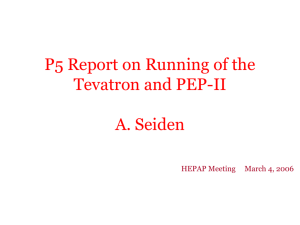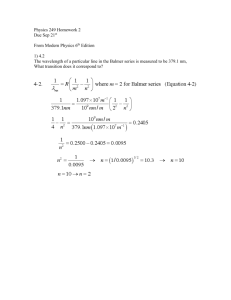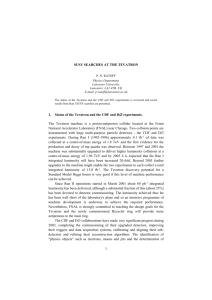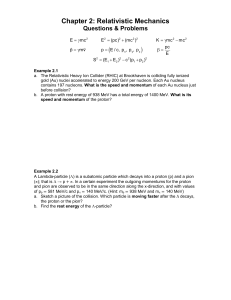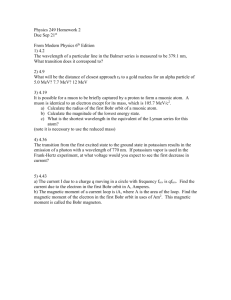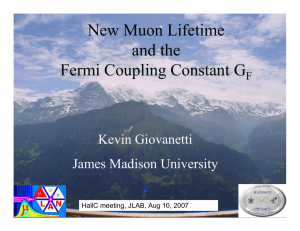p - Glasgow Experimental Particle Physics Internal
advertisement
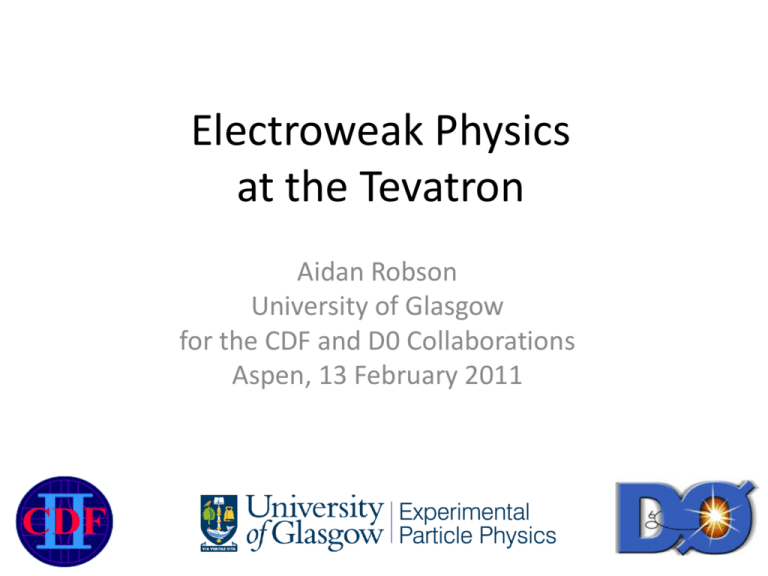
Electroweak Physics
at the Tevatron
Aidan Robson
University of Glasgow
for the CDF and D0 Collaborations
Aspen, 13 February 2011
CDF Zee
(from Stirling, ICHEP04)
2004, using < 100 pb–1
Electroweak Physics at the Tevatron
2
Susy
Higgs
dibosons
top
quark
W/Z
bottom
quark
Jets
Electroweak Physics at the Tevatron
3
Motivation
High-statistics precision measurements
Diboson physics
pT(Z) x3
G(W)
Zg
WZ
ZZ
WW/WZ -> lnjj
Outlook
Electroweak Physics at the Tevatron
4
Tevatron
h = 0.6
h = 1.0
h = 2.0
muon
chambers
D0
CDF
pre-radiator
2
shower max
hadronic cal
had
cal
EM cal
solenoid
1
0
tracker
0
silicon
1
h=1
E
M
cal
2
had cal
h=2
h=3
3 m
Fibre tracker to |h|<1.8
Calorimeter to |h|<4
Muon system to |h|<2
Drift chamber to |h|<1
Further tracking from Si
Calorimeter to |h|<3
Muon system to |h|<1.5
Electroweak Physics at the Tevatron
5
W and Z selection
Electrons:
good EM shower shape
small hadronic energy
isolated in calorimeter
well-matching good track
(except far forward)
Muons:
MIP in calorimeter
isolated
hits in muon chamber
well-matching good track
Z selection:
2 oppositely-charged electrons or muons
invariant mass consistent with mZ
W selection:
exactly one electron or muon
energy imbalance in reconstructed
event, associated with neutrino
Electroweak Physics at the Tevatron
6
pT
E+pz
y1/2 ln E–p
z
[~angular variable]
pZ
antiproton
l–
proton
CDF
2
Z
resummation / parton shower
with non-perturbative model
Z
pQCD reliable
resummation
required
2
Z
0
pT(Z)
multiple
soft gluon
radiation
Z
0
30
0<|y|<1
30 p (Z) 0
1<|y|<2
d/dpT
pT(Z)
d/dpT
Z/g*
d/dpT
q
pT(Z)
l+
q
p
30 p (Z) 0
2<|y|<3
30 p (Z)
distribution
different for
different y?
7
Earlier pT(Z)
Electron channel:
PRL 100 102002 (2008)
Compare 4 models:
Resbos with default parameters
Resbos with additional NLO–NNLO K-factor
NNLO (Melnikov and Petriello)
NNLO rescaled at to data at 30GeV/c
Electroweak Physics at the Tevatron
RESBOS event generator
implements NLO QCD and
CSS resummation
8
pT(Z)
However for comparison with
previous measurement, correct
to 4p and for mass window:
New measurement in muon channel
Presented at the level of particles entering the detector
to avoid model-dependent corrections
Phys. Lett. B 693 522
Electroweak Physics at the Tevatron
9
At particle level:
pT(Z)
Phys. Lett. B 693 522
Electroweak Physics at the Tevatron
10
f*h
aT : component of pT(ll) transverse to dilepton thrust axis.
Less susceptible than pT(ll) to detector effects
Best variable:
fh tan( facop /2)sin( h )
*
*
– highly correlated with aT/mll
( h* measures scattering angle of leptons wrt beam, in rest frame of dilepton system)
Electroweak Physics at the Tevatron
11
f*h
m
m
e
e
Electroweak Physics at the Tevatron
e
arXiv:1010.0262
12
f*h
arXiv:1010.0262
Electroweak Physics at the Tevatron
13
Drell-Yan angular coefficients
Rest frame of dilepton system
LO term
cos2θ :
higher order term
(θ, φ) terms
LO term : determine Afb
Integrate over all
φ,
very small terms
Integrate over all cosθ ,
=0
Electroweak Physics at the Tevatron
=0
14
Drell-Yan angular coefficients
A2=A0 at LO
‘Lam-Tung’ relation
True only for spin-1 gluons,
strongly broken for scalar gluons
Electroweak Physics at the Tevatron
15
Drell-Yan angular coefficients
A4 sensitive to Weinberg angle
A4 using 2.1 fb-1 data = 0.1098 ± 0.0079
Translated to sin2θW in FEWZ :
sin2θW = 0.2331±0.0008
Translated sin2θW in POWHEG :
sin2θW = 0.2328±0.0008
Electroweak Physics at the Tevatron
CDF Run II Preliminary
16
W charge asymmetry
d
u
u
p
u
u
d
p
W±
l±
n
d (W+)/dy – d (W–)/dy
AW(y)
d (W+)/dy + d (W–)/dy
Al(h)
d (l+)/dh – d (l–)/dh
d (l+)/dh + d (l–)/dh
= A(yW) (V–A) ~
d(x)
u(x)
Run 1 measurement resulted in d quark
increased by 30% at Q2=(20GeV)2
Electroweak Physics at the Tevatron
17
W charge asymmetry
Electroweak Physics at the Tevatron
18
mW
m W:
D0: mW = 80402 ± 43 MeV/c2
CDF: mW = 80413 ± 48 MeV/c2
Tev: mW = 80420 ± 31
MeV/c2 (includes Run 1)
LEP: mW = 80376 ± 33 MeV/c2
CDF
DmZ (stat)
published (200/pb)
43 MeV
expected (2.3/fb)
13 MeV
Heading to CDF 25MeV/c2 measurement
Electroweak Physics at the Tevatron
19
GW
GW predicted in Standard Model:
GWSM = 2091±2 MeV (PDG)
Tev error improves from 62 to 49 MeV
Electroweak Physics at the Tevatron
20
Dibosons
W/Z
q
W/Z/g
q’
W/Z/g
Wg Zg WW tt WZ t ZZ
Electroweak Physics at the Tevatron
H→
WW
21
Zg
g
Using (Z→ll)+g
and (Z→nn)+g
g
Z
Z
non-SM
g
non-SM
h3, ZZg
events
Z
SM
|h3| < 0.037, |h4| < 0.0017
@95%CL (L=1.2TeV)
photon ET (GeV)
h , Zgg
22
WZ
q
W
W
q’
Z/g
σ(pp → WZ) / σ(pp → Z)
= (5.5 ± 0.9) x 10-4
σ(pp → WZ)
= (4.1 ± 0.7) pb
23
WZ
σ(pp → WZ)
= (3.9 +1.01
(stat+sys) ± 0.31 (lumi)) pb
–0.85
arXiv:1006.0671
Electroweak Physics at the Tevatron
24
WZ
0.075 Z 0.093
0.027 D Z 0.080
arXiv:1006.0671
for L=2TeV
Electroweak Physics at the Tevatron
25
ZZ4l
q
q’
Z
Z
ZZ seen in 4 lepton at 5.7σ
All now observed!
Wg Zg WW tt WZ t ZZ
H→
WW
σ(pp → ZZ) / σ(pp → Z)
= (2.3+1.5-0.9 (stat) ± 0.3 (syst)) x 10-4
σ(pp → ZZ )
= (1.7 +1.2-0.7 (stat)
± 0.2 (syst)) pb
26
ZZllnn
Electroweak Physics at the Tevatron
27
WW/WZ lnjj
Similar final state
to low-mass Higgs:
Electrons
Electroweak Physics at the Tevatron
Muons
28
WW/WZ lnjj
σ(WW+WZ )
= (18.1 ± 3.3(stat)
5.4 ± 2.5(sys) )pb
5.2 significance
Electroweak Physics at the Tevatron
29
WW/WZ lnjj
Use matrix
element
techniques
σ(WW+WZ )
= (16.5 +3.35.4
-3.0) pb
5.4 significance
Electroweak Physics at the Tevatron
30
Tevatron outlook
Integrated luminosity (pb–1)
End : Sep 2011(?)
On tape: ~ 8.5 fb-1 per experiment
Results shown today : 1-7 fb-1
2002
now
Electroweak Physics at the Tevatron
31
Outlook
♦ Completing strong electroweak physics programme
♦ Focusing on high-statistics Tevatron legacy measurements
and diboson physics underpinning symmetry-breaking searches
Electroweak Physics at the Tevatron
32
33
34
WW/WZ lnjj
differences q.g jets
Electroweak Physics at the Tevatron
35
WW scattering
W+
W+
Z/g
W–
W–
W+
H
W+
W+
W+
W+
W–
W–
W–
W+
required to
cancel highenergy
behaviour
Z/g
W–
W+
W+
H
W–
W–
W–
W–
36
W/Z primitive objects
for non-collider physicists
Electroweak Physics at the Tevatron
37
p
g
H
p
g
Electroweak Physics at the Tevatron
38
PDFs
p
g
H
p
g
pp→H = gg→H fg/p(x1,Q=MH) fg/p(x2,Q=MH) + …
Tevatron
y=
2
0
2
LHC
Higgs Physics at the Tevatron
39
Matrix element method
Use LO matrix element (MCFM) to compute event probability
xobs:
LO |M|2 :
px
px
py
py
lep1
pz
pz
Ex , E y
lep2
(with true values y)
HWWlnln
WWlnln
ZZllnn
W+partonln+jet
Wgln+g
parton lepton fake rate
g conversion rate
ET model
lepton energy resn
Compute likelihood ratio discriminator
R=
Ps
Ps + SkbiPbi
kb is relative fraction of expected background contrib.
Ps computed for each mH
i
Fit templates (separately for high S/B and low S/B dilepton types)
Higgs Physics at the Tevatron
40/54
Neural network method
Various versions. Current:
Apply preselection (eg ET to remove Drell-Yan)
Train on {all backgrounds / WW} against Higgs
mH=110,120…160…200 { possibly separate ee,em,mm}
score
var1
ET
SET
mll
Elep1
Elep2
ETsig
ETjet1
DRleptons
Dfleptons
Df ET lep or jet
ETjet2
Njets
Most recent CDF
“combined ME/NN”
analysis also uses
ME LRs as NN input
variables
NN
var2
var n
x10
0
1
Background Higgs
Pass signal/all backgrounds through net
Form templates
Data
HWW
WW
DY
Wg
WZ
ZZ
tt
fakes
NN
0
1
Pass templates and data to fitter
Higgs Physics at the Tevatron
41/54
mt
xobs:
px
py
pz
px
py
pz
lep1
Matrix element-based top mass measurement
Lepton+jets with 4.8fb-1
NN for background discrimination
Likelihood fit over variables sensitive to top mass
Simultaneous constraint of jet energy scale using W in lepton+jets
More precise than CDF 2009!
Expect 1GeV precision achievable
Higgs Physics at the Tevatron
Ex , E y
etc.
jet1 (true values y)
ET model
lepton energy resn
mt =172.8 ± 1.3total GeV
(0.7stat 0.6JES 0.8sys)
42
Single top
d
u
l
l
W
W
b
t
g
W
Single top observed 2009.
b
b
b
t
n
W
d
s-channel
b
t-channel cross section [pb]
t-channel
n
u
s-channel cross sectionHiggs
[pb]
Physics at the Tevatron
43
Limit setting
Higgs signal x 10
H1=SM+Higgs (of mass mH)
H0=SM only
X
X = some observable
Construct test statistic Q = P(data|H1)/P(data|H0)
–2lnQ = c2(data|H1) – c2(data|H0) ,
marginalized over nuisance params except H
0
Find 95th percentile of resulting H distribution
– this is 95% CL upper limit.
Repeat for pseudoexperiments drawn from
expected distributions to build up expected
outcomes
Median of expected outcomes is “expected limit”
95%
rescale
1
2
H (pb)
0
2
H/SM
Median = expected limit
Expected outcomes
When computed with collider data this is the
“observed limit”
95%
PDF
signal
separation
Background
events
background
suppression
95% CL Limit/SM
Higgs Physics at the Tevatron
44
Indirect constraints
e+
e–
Z
Z
H
mH>114GeV
b
b
mH<154GeV
estimated
final precision
45
Integrated luminosity (fb–1)
Tevatron projection
End : Sep 2011?
On tape: ~ 6 fb-1 per experiment
Results shown today : 3-5 fb-1
Higgs Physics at the Tevatron
46
W charge asymmetry
PRD 71 052002
First Run 2 charge asymmetry measurement: similar approach to Run 1
measurement relies on calorimeterseeded silicon tracking
experimental challenges:
alignment; charge misidentification
|he|
unknown neutrino pZ is a smaller effect
for higher ET electrons
measurement divided into two ET
regions
|he|
Aidan Robson
for given he, ET regions probe different
yW and therefore different x
Glasgow University
47/22
W charge asym. – new method
Instead: probe the W rapidity directly
MW constraint two kinematic solutions for pz of n.
Ambiguity can be resolved statistically from known
centre-of-mass * distribution for V-A decay
weight solutions according to (cos*, y, pTW )
d/dy is an input; iterate to remove dependence.
Relies on Si-only tracking
Uncertainties:
Charge mis-ID rate
Energy scale and mismeasurement
Background/trigger/electron ID
cos*
Aidan Robson
Glasgow University
cos*
48/22
W charge asym. – new method
Under improvement using better
forward tracking and higher stats
Aidan Robson
Glasgow University
49/22
Generator:
LO MC
matched with Resbos (QCD ISR)
and Berends/Kleiss (QED FSR)
W width
c2/dof=27.1/22
Fast simulation for templates:
electron conversions + showering
muon energy loss
parametric model of recoil energy
(QCD, underlying event + brem)
Tracking scale/resn
DG 17 MeV, 26 MeV
mmm (GeV)
DG 54 MeV (ele), 49 MeV (mu)
Backgrounds
c2/dof=18/22
Calorimeter scale/resn
DG 21 MeV, 31 MeV
DG 32 MeV
mT (GeV)
DG 33 MeV
mT (GeV)
mee (GeV)
W width
PRL 100 071801 (2008)
GW = 2032 ± 73 (stat+sys) MeV
Compare to CDF indirect measurement:
( pp W )
G(Z)
G(W l n )
R
( pp Z) G(Z ll )
G(W )
NNLO calc
From LEP
World most precise
single measurement
(GWSM = 2091 ± 2 MeV)
SM value
GW (indirect) = 2092 ± 42 MeV
J Phys G 34 2457



